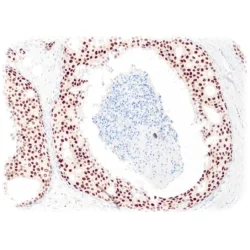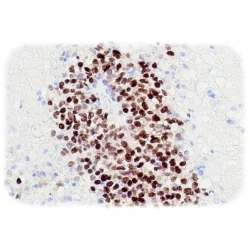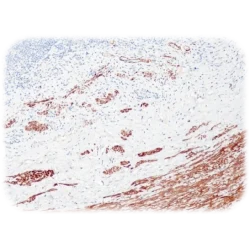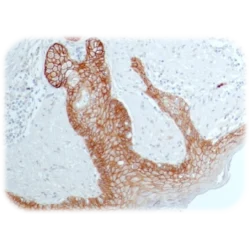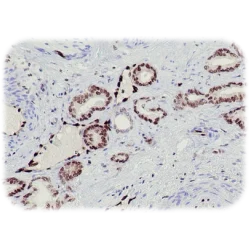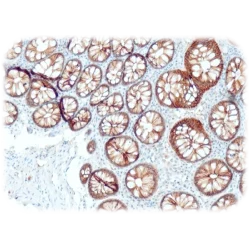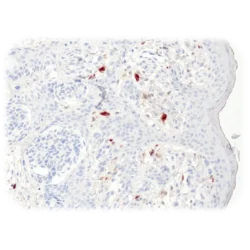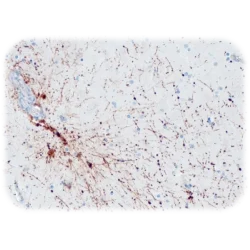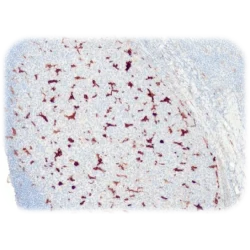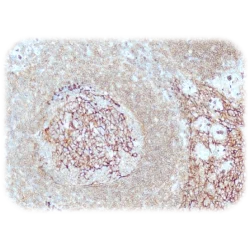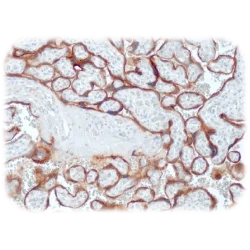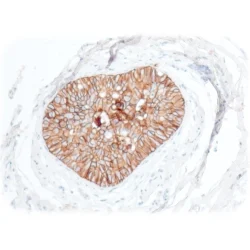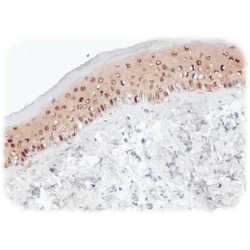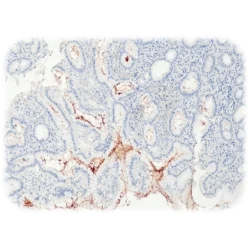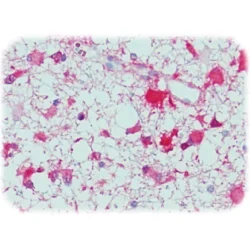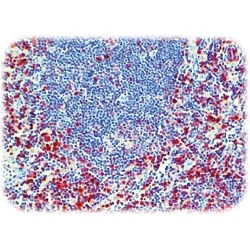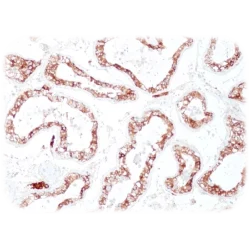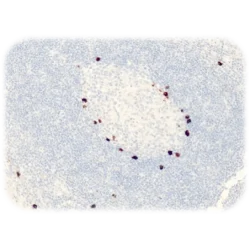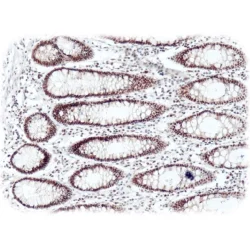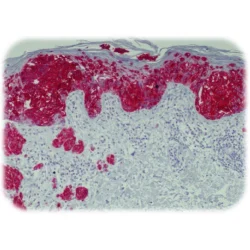دسته: مونوکلونال
نمایش 341–360 از 412 نتیجه
فیلتر ها-
Quartett
آنتی بادی ER(Estrogen Receptor) کلون QR013 برند Quartett
نمره 0 از 5Estrogen receptor (ER) is a nuclear hormone receptor that activates transcription of various genes, especially in reproductive tissues, regulated by its ligand estrogen. ER is expressed in approximately 70% of all breast cancer cases. It is reported that patients with ER-positive tumors have better prognosis than patients with ER-negative tumors.
-
Quartett
آنتی بادی GATA3 کلون QR018 برند Quartett
نمره 0 از 5GATA3 is a zinc finger protein regulating as transcription factor the development of various tissues and cell types, including early T cell development and development of mammary gland. Expression is found in breast epithelium, urothelial cells, and a subset of lymphocytes. Anti-GATA3may be used for identification of breast carcinoma or urothelial carcinoma.
-
Quartett
آنتی بادی Desmin کلون QR026 برند Quartett
نمره 0 از 5Desmin is a muscle-specific intermediate filament protein type III and is found in the dense bodies of smooth muscle cells and in the Z-disk of striated muscles. Desmin connects the contractile apparatus to the subsarcolemmal cytoskeleton and organelles like nuclei. It also forms a scaffold around the myofibrillar Z-disk. It is useful in the detection of tumors with myoid origin and to differentiate mesothelioma from carcinoma.
-
Quartett
آنتی بادی EGFR(Epidermal Growth Factor Receptor) کلون QR078 برند Quartett
نمره 0 از 5Epidermal growth factor is a growth factor that stimulates cell growth, proliferation, and differentiation by binding to its receptor EGFR. EGFR is a receptor tyrosine kinase activating several signaling cascades. It is ubiquitously expressed and observed in tumors of head and neck, brain, bladder, stomach, breast, lung, endometrium, cervix, vulva, ovary, esophagus, stomach, and in squamous cell carcinoma. Overexpression of EGFR in tumors indicates poor prognosis.
-
Quartett
آنتی بادی Transcriptional Regulator ERG کلون QR040 برند Quartett
نمره 0 از 5ERG, also known as ETS related gene, is a member of the ETS family of transcription factors that play important roles in cell development, differentiation, proliferation, apoptosis and tissue remodeling. The antibody labels endothelial cells, lymphocytes, and prostate cancer cells. Overexpression of ERG is associated with prostate cancer. Furthermore, the TMPRSS2-ERG fusion caused by translocations and interstitial deletions, is implicated in aggressive forms of prostate cancer. EWS-ERG, or EWS-Fli-1 fusion, is a characteristic of Ewing’s sarcoma.
-
Quartett
آنتی بادی Cadherin E کلون QR035 برند Quartett
نمره 0 از 5E-cadherin is a transmembrane protein that is important for epithelial cell adhesion. It maintains the structural and functional integrity of epithelial tissues. Reduced or aberrant E-cadherin expression breaks cell to cell contacts, and thus, cells acquire the ability to migrate. In normal tissues, E-cadherin is localized to the membrane of epithelial cells, consistent with its role in cell adhesion. In tumor tissues, E-cadherin stains positively in the glandular epithelium and adenocarcinomas of the lung, gastrointestinal tract, and ovary. It has also been shown to be positive in some thyroid carcinomas. The antibody has been useful in distinguishing adenocarcinoma from mesothelioma. In combination with p120 or cytokeratin it involves the differentiation of ductal (E-cadherin positive) and lobular (E-cadherin negative) breast carcinoma. Several studies have reported that reduced E-cadherin expression is correlated with poor prognosis in several types of carcinomas.
-
Quartett
آنتی بادی Factor 13a کلون QR086 برند Quartett
نمره 0 از 5Factor XIII is activated in the blood coagulation cascade by thrombin and calcium to a transglutaminase stabilizing the fibrin clot. This antibody detects the coagulation factor XIIIa subunit. Defects in factor XIIIa cause factor XIII subunit a deficiency an autosomal recessive disorder characterized by a lifelong bleeding tendency, defective wound healing, and habitual abortion.
-
Quartett
آنتی بادی GFAP(Glial Fibrillary Acidic Protein) کلون QR066 برند Quartett
نمره 0 از 5Glial fibrillary acidic protein is an intermediate filament protein that is expressed by numerous cell types of the central nervous system. In the central nervous system, GFAP is expressed in astrocytes and ependymal cells but not in other glial cells. However, immature oligodendrocytes and immature choroid plexus cells may be GFAP positive. In the peripheral nervous system enteric Schwann cells and satellite cells of human sensory ganglia express GFAP. Outside the nervous system, GFAP is seen in myoepithelial cells and chondroblasts, in the former coexpressed with cytokeratin, in the latter coexpressed with vimentin. Astrocytoma, ependymoma, glioblastoma, and oligodendroglioma are almost always positive. Plexus carcinoma, ganglioglioma and primitive neuroectodermal tumours (PNET: neuroblastoma a.o.) express GFAP to a varying extent. Schwannoma and neurofibroma frequently express GFAP. Chondroma, chondrosarcoma and pleomorphic adenoma are also GFAP positive in most cases. A few carcinomas (especially from lung and breast) may express GFAP. in paraganglioma GFAP may be detected in sustentacular cells. This marker is mainly used to distinguish neoplasms of astrocytic origin from other neoplasms in the central nervous system.
-
Quartett
آنتی بادی Glutamine Synthetase کلون QR090 برند Quartett
نمره 0 از 5Glutamine synthetase (GS) converts ammonia and glutamate to glutamine. Glutamine synthetase has multiple metabolic functions. Two of them are detoxification of ammonia, and regulation of glutamate in neurons. Synthesis and catalytic activity of glutamine synthetase are highly regulated.
-
Quartett
آنتی بادی GLUT1 کلون QR082 برند Quartett
نمره 0 از 5Glucose transporters are a wide group of membrane proteins that facilitate the transport of glucose over a plasma membrane. GLUT1 is a membrane-associatederythrocyte glucose transport protein that is a major glucose transporter in the mammalian blood-brain barrier. GLUT1 is expressed in many human tissues like colon, lung, stomach, esophagus, and breast. It is over expressed in malignant cells and in a variety of tumors (breast, pancreas, cervix, endometrium, lung, mesothelium, colon, bladder, thyroid, bone, soft tissues, and oral cavity).
-
Quartett
آنتی بادی Glypican 3 کلون QR103 برند Quartett
نمره 0 از 5Glypican 3 (GPC3) is a memer of glypican family of heparan sulfate proteoglycans that are anchored to the cell-surface via a covalent linkage to glycosylphosphatidylinositol. Glypicans can modify cell signaling pathways and contribute to cellular proliferation and tissue growth. Glypican 3 is a useful tumor marker for the diagnosis of hepatocellular carcinoma, hepatoblastoma, melanoma, testicular germ cell tumors, and Wilms tumor.
-
Quartett
آنتی بادی C-erbB-2(HER2) کلون QR003 برند Quartett
نمره 0 از 5Her2/Neu is a member of human epidermal growth factor family and encodes for a receptor tyrosine kinase involved in signal paths of growth factors.
Her2/Neu activation occurs in various tumors, mostly through gene amplification which results in high level overexpression. Her2/Neu amplification and overexpression is particularly common in breast cancer but can – at lower frequency – also occur in many other tumor entities. Numerous studies have demonstrated the prognostic relevance of Her2/Neu, which is overexpressed in 10% to 40% of human breast tumors. -
Quartett
آنتی بادی HSP70(Heat Shock Protein 70) کلون QR087 برند Quartett
نمره 0 از 5HSP70 is a heat shock protein of 70kDa. It prevents aggregation of other proteins in conjunction with other heat shock proteins and mediates folding of new proteins during synthesis.
-
Quartett
آنتی بادی Helicobacter Pylori کلون QR091 برند Quartett
نمره 0 از 5Helicobacter pylori (H. pylori) is a spiral-shaped, gram negative rod bacterium that is found in human stomach, despite there is an extreme acidic pH. Infections of gastric mucosa lead to gastric diseases like stomach ulcers or chronic gastritis. Furthermore, an infection with H. pylori is linked with the formation of gastric cancer and MALT lymphoma (MALT = Mucosa Associated Lymphoid Tissue). The antibody is useful for detecting the bacterial infection in gastric and duodenal epithelial cells.
-
Quartett
آنتی بادی IDH1 R132H(Isocitrate Dehydrogenase 1) کلون QM002 برند Quartett
نمره 0 از 5Isocitrate dehydrogenase 1/ IDH1 is an enzyme that catalyzes the third step of the citric acid cycle, which involves the oxidative decarboxylation of isocitrate, forming alpha-ketoglutarate and CO2 in a two-step reaction. The IDH1 protein is localized in the cytoplasm and in peroxisomes. It is expressed in a wide range of species and also in organisms that lack a complete citric acid cycle. Gliomas are the most frequent primary CNS malignancy.
The two common types of gliomas are astrocytomas and oligodendrogliomas. Three pathways of glioma development have been identified: primary glioblastomas that arise de novo without lower grade precursors, astrocytomas that start as grade II or III and then transform into secondary glioblastoma, or oligodendrogliomas that can transform into anaplastic oligodendroglioma.
IDH1 R132H point mutation is shown in more than 70 % of gliomas, frequently in WHO grade II and III gliomas and secondary grade IV glioblastomas.
The antibody QM002 is highly specific for the R132H point mutation allowing a diagnosis of astrocytomas or oligodendrogliomas.
The high rates of IDH1 mutations in oligodendroglial tumors make this mutation especially helpful for the differentiation of oligodendrogliomas from other tumors with clear cell appearance. IDH1 mutations have been shown to dominantly inhibit IDH1 catalytic activity.
Assessment of the IDH1 status may be performed by immunohistochemical detection of the mutated protein. In cases with negative or inconclusive immunostaining result further analysis by DNA-based methods is necessary. Testing of the IDH1 status is relevant for diagnostic and prognostic considerations in primary brain tumors. Mutated tumors generally show a better prognosis. -
Quartett
آنتی بادی IRTA1 کلون QM005 برند Quartett
نمره 0 از 5Immunoglobulin superfamily receptor translocation associated 1 (IRTA1) is a surface B-cell receptor related to Fc receptors, inhibitory receptor superfamily (IRS) and a cell adhesion molecule (CAM) family member. It is expressed by B cells near to glandular epithelium in the tonsil and Peyer patches and by monocytoid B cells. In lymphomas it is expressed by tumor cells involved in lymho-epithelial lesions.
Anti-IRTA1 is suitable for detection of marginalzone lymphomas in lymph nodes and extranodal locations. -
Quartett
آنتی بادی Inhibin Alpha کلون QR088 برند Quartett
نمره 0 از 5Inhibin down regulates FSH synthesis and inhibits FSH secretion. This antibody recognizes a protein of 32 kDa which is identified as Inhibin alpha. It helps in the differentiation between adrenal cortical tumors and renal cell carcinoma and it detects sex cord stromal tumors of the ovary as well as trophoblastc tumors.
-
Quartett
آنتی بادی IgG4 کلون QR092 برند Quartett
نمره 0 از 5Immunoglobulin G is the most abundant antibody isotype found in the circulation. Human IgG4, one of four subclasses of IgG, contains a gamma 4 heavy chain and a hinge region that is shorter than that of IgG1. The two primary effector functions are activating complements and binding to the FcgR of effector cells to initiate phagocytosis. Human IgG4 accounts for less than 6 % of the total IgG serum level. IgG4-related sclerosing disease has been recognized as a systemic disease entity characterized by an elevated serum IgG4 level, sclerosing fibrosis, and diffuse lympho-plasmacytic infiltration with the presence of many IgG4-positive plasma cells. IgG4 is overexpressed in inflammatory pseudo-tumor (IPT) and under expressed in inflammatory myofibroblastic tumor (IMT). In pulmonary nodular lymphoid hyperplasia (PNLH), there are an increased number of IgG4+ plasma cells.
-
Quartett
آنتی بادی MLH1 کلون QM003 برند Quartett
نمره 0 از 5DNA mismatch repair (MMR) system consists of four major proteins called MLH1, MSH2, MSH6, and PMS2. These proteins work two by two, MLH1 with PMS2 and MSH2 with MSH6. Loss of function of one of the four proteins leads to inactivation of the MMR system, resulting in a loss of fidelity of the replication and an accumulation of mutations thereby leading to microsatellite instability (MSI).
MSI is associated with hereditary nonpolyposis colorectal cancer (HNPCC, Lynch syndrome), which is characterized by the development of colorectal cancer, endometrial cancer and various other tumors at early age.
Loss of MLH1 function due to gene mutation or epigenetic changes is characterized by absence of nuclear expression in neoplastic cells, whereas intact nuclear MLH1 expression indicates normal MLH1 function and no gene mutations. MLH1 is normally expressed in most cases of sporadic colorectal cancer, loss of MLH1 expression is found in 30-40%.
Anti-MLH1 is useful in detection of MSI, especially in a panel with MSH6 (QR011), PMS2 (QR009) and MSH2 (QR010). -
Quartett
آنتی بادی MELAN A(MART1) کلون A103 برند Quartett
نمره 0 از 5Melan A (A103), also known as MART-1 (melanoma antigen recognized by T-cells 1), is an important immunohistochemical marker for the diagnosis of maglignant melanoma. The protein is expressed on the surface of melanocytes and is located in normal skin, retina and nevi.

